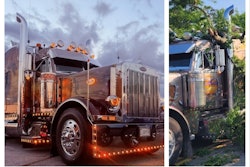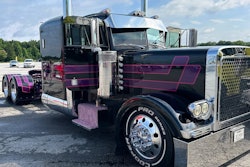Driver Steve Carney looks for the artist’s signature on the stainless steel surface of the 67-foot piece of art.
An artist pulls up a grown apple tree by its roots and sends it off to a forge to be bronzed.
Steve Carney, a driver for Jeff Dagen Trucking in New York, hauled that bronzed tree from the Tallix Foundry in Beacon, N.Y. back to its original home amidst other apple trees. “I don’t know if it’s art,” Carney says, “But it must have been expensive.”
Especially when you add the ceramic apples and the leaves made by the French artist and imported to make the tree look just right. “I took that apple tree back and they put it back in the same place, except they moved it four feet away from the rest of the row. And that’s what made it art, they said,” says Carney.
Tallix does a lot of work with artists, and Carney is here again on a Friday in early September to load a sculpture headed for the new National Air and Space Museum at Dulles Airport in Virginia, just 25 miles west of Washington, D.C. Created by John Safer, a sculptor with many large pieces to his credit, it is a 67-foot tall, 9,000-pound creation made of polished stainless steel.
At its base it is more than 11 and a half feet wide, and it spirals toward its top, becoming slimmer as it twists toward the final thickness of a needle. It has been fabricated in two pieces, each about 35 feet long, to facilitate transportation. At its break about halfway up is a jagged line fitted with stainless steel nipples, which will fit into holes on the other piece to hold it in place when it is erected. After it is positioned, the seam will be welded, ground and polished to provide those who see it with the unblemished illusion of a single continuous piece of steel that soars weightlessly skyward, like flight itself. Called “Ascent” by the artist, the nearly hollow steel construction is meant to capture the human experience of flight.

Safer says he designed this piece so that it could be transported and erected. “I started with a vision and worked backwards so that it could be transported to the museum and set so that when it is up people can see the flow of it.” Ascent is actually made of a number of sections welded together. “The base is made in sections, but the top piece is hollow,” the artist says. The highly polished skin is 1/2-inch stainless reinforced with an internal hatchwork of steel beams.
“The state of Virginia required Ascent to be certified for safety,” says Lin Ezell, program coordinator for the National Air and Space Museum, Steven F. Udvar-Hazy Center. “They were concerned that it have the structural strength to stand for a very long time.” Safer believes his piece will indeed last for a very long time. “It should be polished at least every 100 years,” he adds wryly.
Despite the best intentions of the artist, there are Friday morning loading problems. Kurt Wulfmeyer, superintendent of fabrication for Tallix, is expecting two trucks. But the logistics specialist hired to move Ascent, Ruediger Hilken, owner of Hilken International in Beacon, N.Y., is quite sure both pieces can be fit on one truck. It certainly looks that way, but Wulfmeyer and Tallix officials are just as certain it will take two. In the end, another truck is ordered, and the base is loaded onto Carney’s flat. The base is under 12 feet so pilot cars will not be needed, and Carney makes plans to leave at the crack of dawn Monday for a Tuesday morning delivery. Permitted loads do not move on the weekends in this part of the country, and there are plenty of bridges and beltways whose curfews make the trip impossible until Monday.
The 35-foot base of Ascent was lowered by crane onto its trailer at Tallix foundry.
The crane arrives and lifts the 35-foot section so that it sits squarely on the flat. Carney makes sure the overhang on each side of the trailer is equal, and he is happy that it is only a foot and a half on each side of his 96-inch wide platform. A few straps and padding to keep the polished steel edges from cutting through the straps secure Ascent. Carney puts his flags and signs on the load and pulls it around back out of the way. The second truck has been ordered and will be here before noon to load. That piece will be pulled by Mike Guenette, another Dagen driver. Only the base is oversized, and Guenette will probably be on site long before Carney gets there late Monday or early Tuesday.
At 6 a.m. Monday the yard is empty. Only Hilken is here. But Carney shows up in plenty of time to make the 350-mile run to Dulles before sundown, and we are on our way. Carney’s late model Mack is powered by a 465 Mack, and the 6,000-pound base of this piece of fine art will not slow him down. And unless there are permit problems or problems at a weigh station, its width will make little difference in how long it takes to make delivery. We stop twice during the day. Just inside the Keystone, Carney pulls in to check his load. A man introduces himself and asks what Carney is carrying. He is an engineer and remarks that he knows it “doesn’t do anything.” Carney explains it is fine art, and the engineer grins and says, “Now I know it doesn’t do anything.”
The only permit Carney does not already have is from Virginia. We stop at the Petro outside of Scranton to pick it up, but it’s not there. A flurry of phone calls gets the permit delivered, and we don’t stop again until we are sitting in front of the new Udvar-Hazy Center, two hours before sunset. Carney has made good time and has not had to worry much about his load. Despite its width, it sits high off the trailer and is easily visible in the mirrors.
Next morning the crane is set up and Wulfmeyer is supervising the rigging. Carney and Guenette have their straps rolled and are ready to go when Ezell offers us a tour of the new facility. Constructed to resemble an airport, the building is gigantic – 968 feet long, 248 feet wide and 108 feet high. Far above the main building, a tower resembling an air traffic control tower rises 168 feet.
For an hour we wander the catwalks high in the air above the hangar floor looking at P-38s, F-4s, small acrobatic aircraft and the Enola Gay, the B-29 Super Fortress that dropped the first atomic bomb on Japan. Most of the planes are hung by wire.
Outside, Ascent is rising. The base has been rigged to drop flat onto its dozen or so steel rods, threaded to allow the sculpture to be bolted to the concrete mount. Wulfmeyer and his helper are 35 feet in the air, rigging the second piece into the key-like mount at the top of the base. From their cherry picker, they manhandle the 3,000-pound upper portion until its nipples align with the holes made for them. By 3 p.m., the entire piece rises into the air, its full height wrapping dramatically around the museum’s tower, far in the background.
It is startling to see the entire piece after having driven with it, having seen it hung with chains in the air while being lifted. Now, entirely unencumbered, Ascent looms in the sky looking as if it might somehow lift off the earth of its own accord.
Imagine the size of the cereal bowl! This is “Spoonbridge and Cherry”, created by famous international artist Claes Oldenburg and his wife Coosje von Bruggen, a $200,000 art work
en route from Bristol, R.I., to the Walker Arts Center in Minneapolis.
Giant Spoons and Hollow Barnacles
When a large piece of sculpture is going down the road on a truck, it attracts a different kind of attention than it might get after its installation.
Paul Bestoso, marketing director for Merrifield Roberts, a fabricating firm specializing in large outdoor pieces in Bristol, R.I., says his company has built and loaded plenty of fine public art. “We’ve taken giant spoons to Minneapolis, a giant shuttlecock to Kansas City, and we just finished trucking nine 65-foot high bowling pins to Disney World,” Bestoso says. “That move took 27 trucks, three for each bowling pin. We pieced the pins together when we got them to Florida. We’ll be taking a 35-foot sculpture of Buck Rogers’ space ship soon.”
Bestoso says not all art goes on flatbeds. And there are a few companies specializing in moving shows and in transporting smaller pieces like paintings and artifacts from museum to museum. Fine Arts Express of Boston uses both straight trucks and tractor-trailers to move museum pieces. In such moves, crating and packing are significant aspects of the job. Fine art is high-dollar freight, and white glove service is the norm. But when you’ve got aluminum trees that need a double drop to transport, the gloves come off. Yes, the pieces are treated with respect and generally arrive unscathed. Nevertheless cranes and rigging are the only means to install the big stuff.
On tap for Merrifield Roberts is a 30-foot by 60-foot, 30-foot tall piece that “looks like a barnacle,” according to Bestoso. “That piece is going to the Ministry of Art in Qatar, a small country in the Middle East. It will be containerized in sections and assembled there. The barnacle will be hollow and will accommodate visitors,” says Bestoso. “It will be made of double aluminum walls, will be insulated and air conditioned.” You can’t get any finer than that.








